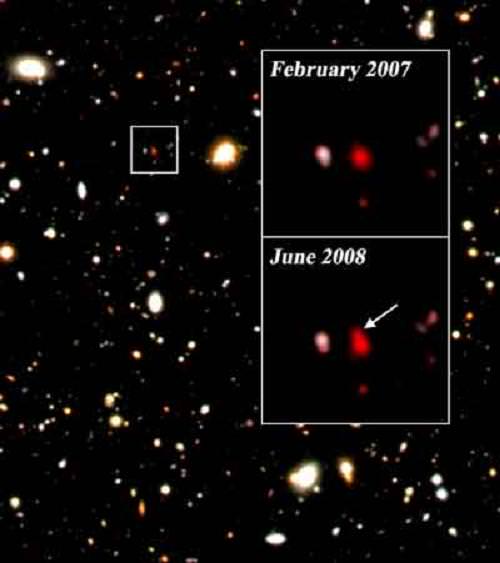Type Ia supernovae… Right now they are one of the most studied – and most mysterious – of all stellar phenomenon. Their origins are sheer conjecture, but explaining them is only half the story. Taking a look back into almost the very beginnings of our Universe is what it’s all about and a team of Japanese, Israeli, and U.S. astronomers have employed the Subaru Telescope to give us the most up-to-date information on these elementally explosive cosmic players.
By understanding the energy release of a Type Ia supernova, astronomers have been able to measure unfathomable distances and speculate on dark energy expansion. It was popular opinion that what caused them was a white dwarf star pulling in so much matter from a companion that it finally exploded, but new research points in a different direction. According to the latest buzz, it may very well be the merging of two white dwarfs.
“The nature of these events themselves is poorly understood, and there is a fierce debate about how these explosions ignite,” said Dovi Poznanski, one of the main authors of the paper and a post-doctoral fellow at the University of California, Berkeley, and Lawrence Berkeley National Laboratory.
“The main goal of this survey was to measure the statistics of a large population of supernovae at a very early time, to get a look at the possible star systems,” he said. “Two white dwarfs merging can explain well what we are seeing.”
Can you imagine the power behind this theory? The Type Ia unleashed a thermonuclear reaction so strong that it is able to be traced back to nearly the beginning of expansion after the Big Bang. By employing the Subaru telescope and its prime focus camera (Suprime-Cam), the team was able to focus their attention four times on a small area named the Subaru Deep Field. In their imaging they caught 150,000 individual galaxies containing a total of 40 Type Ia supernova events. One of the most incredible parts of these findings is that these events happened about five times more frequently in the early Universe. But no worries… Even though the mechanics behind them are still poorly understood, they still serve as “cosmic distance markers”.
“As long as Type Ias explode in the same way, no matter what their origin, their intrinsic brightnesses should be the same, and the distance calibrations would remain unchanged.” says Alex Filippenko, UC Berkeley professor of astronomy.
Original Story Source: University of Berkeley News Release. For Further Reading: National Astronomical Observatory of Japan: Subaru News Release.


Here is the source paper: http://arxiv.org/PS_cache/arxiv/pdf/1102/1102.0005v3.pdf
Impacts again? (See Uranus on tilts.)
At least, this time they seem to hit the right spot.
And it is fun to see two rather opposite alternatives battle it out! [/takes popcorn out of micro]
Unfortunately, my brain is relatively powerless to do so. (IIRC, ~ 100 W effect out of a typical ~ 200 W body consumption, when going at full “warp”. Or whatever brains do.)
That is some 42 orders of magnitude less than the power observed in this context.
“One of the most incredible parts of these findings is that these events happened about five times more frequently in the early Universe.”
Why not? Would not a higher frequency of collision/merger events occur in the early hotter, denser, more chaotic star forming universe?
Wouldn’t the collision of two white dwarfs exceed the 1.44 solar masses limit at which a Type Ia SN usually occurs? How can these Type 1a explosions be uniform when the masses of the two white dwarfs is unknown? It seems this would add variability to Type 1a’s, and make them a dubious standard candle.
I was going to make the same point. Can anyone rationalise how the collision option can be quantitatively uniform?
The 1.4 solar mass limit is the Chandrasekhar limit IIRC.
That would be the (a) core collapsing to a neutron star or black hole, never mind the mass of the outer shell or merging star’s surplus.
Wouldn’t the collision of two white dwarfs exceed the 1.44 solar masses limit at which a Type Ia SN usually occurs? How can these Type 1a explosions be uniform when the masses of the two white dwarfs is unknown? It seems this would add variability to Type 1a’s, and make them a dubious standard candle.